#satellite servicing collaboration
Explore tagged Tumblr posts
Text
Collaborative Opportunities Driving Growth in the Satellite Life Extension Market

The Satellite Life Extension Market is gaining traction as a vital segment of the space industry, with a focus on extending the operational lifespan of satellites. Valued at USD 0.81 billion in 2024, the market is projected to expand at a CAGR of 10.6% through 2029, driven by increasing demand for cost-effective and sustainable satellite solutions. One of the most significant opportunities within this market lies in collaborative innovation, where partnerships between key industry players pave the way for technological advancements and market expansion.
The Role of Collaboration in Satellite Life Extension
Collaboration is the cornerstone of innovation in the satellite life extension market. Strategic partnerships between satellite operators, technology developers, and research organizations enable the pooling of resources and expertise, accelerating the development of advanced on-orbit servicing technologies. These partnerships are instrumental in addressing complex challenges such as robotic repairs, automated docking, and in-space refueling, which are critical to the success of satellite life extension missions.
The combined expertise of multiple stakeholders fosters the creation of innovative solutions that enhance the efficiency and reliability of satellite servicing. For instance, partnerships can integrate advancements in artificial intelligence (AI), human-robot interaction, and engineering to develop next-generation servicing systems. These collaborative efforts not only push the boundaries of technological innovation but also reduce costs and risks associated with developing complex space systems.
Unlocking New Markets Through Partnerships
Collaborative opportunities in the satellite life extension market also facilitate market expansion by enabling companies to leverage each other’s networks and resources. Partnerships between established players and emerging startups create synergies that help penetrate new markets and reach untapped customer segments. This approach is particularly valuable for expanding the adoption of satellite life extension services across different regions and industries.
For example, partnerships with regional satellite operators can provide access to localized knowledge and customer bases, making it easier for companies to introduce life extension solutions tailored to specific market needs. Such collaborations enhance the scalability and accessibility of satellite servicing technologies, ensuring broader adoption and increased market penetration.
Download PDF Brochure: https://www.marketsandmarkets.com/pdfdownloadNew.asp?id=28862068
Driving Innovation Through Shared Expertise
The satellite life extension market thrives on technological innovation, and collaboration plays a critical role in driving this innovation. By combining the strengths of multiple organizations, partnerships can accelerate the development of cutting-edge technologies such as robotic arms, autonomous servicing systems, and AI-driven analytics. These advancements address the unique challenges of operating in the harsh space environment, including extreme temperatures, radiation, and microgravity.
Collaborative initiatives also promote knowledge sharing and skill development, enabling the space industry to build a highly skilled workforce capable of addressing complex technical challenges. This exchange of expertise fosters a culture of innovation, ensuring that the satellite life extension market remains at the forefront of space technology advancements.
Expanding the Scope of Satellite Life Extension Services
One of the most significant benefits of collaboration in the satellite life extension market is the ability to expand the scope of services offered. By pooling resources and expertise, companies can develop comprehensive life extension solutions that go beyond traditional on-orbit repairs and refueling. These solutions may include satellite upgrades, performance optimization, and end-of-life management, providing a holistic approach to satellite sustainability.
For instance, partnerships between technology developers and satellite operators can lead to the creation of modular servicing systems that cater to a wide range of satellite platforms. These systems offer flexibility and scalability, allowing operators to customize life extension solutions based on their specific needs. This expanded scope of services enhances the value proposition of satellite life extension, attracting a broader range of customers and driving market growth.
Overcoming Challenges Through Collaboration
The satellite life extension market faces several challenges, including high development costs and technical complexities. Collaborative efforts provide an effective way to address these challenges by sharing the financial burden and leveraging complementary expertise. Partnerships enable companies to pool resources for research and development (R&D), reducing the cost and risk of developing advanced servicing technologies.
Moreover, collaboration fosters a supportive ecosystem that encourages innovation and problem-solving. By working together, companies can overcome technical hurdles such as precision docking, reliable robotic systems, and fuel transfer mechanisms. This collaborative approach ensures the successful execution of satellite life extension missions, building confidence in the market and attracting further investment.
The Importance of Collaboration in Space Sustainability
Space sustainability is a critical concern for the global community, and collaboration is essential to achieving this goal. The satellite life extension market plays a pivotal role in reducing space debris by extending the operational life of satellites and minimizing the need for deorbiting. Collaborative initiatives promote responsible space practices by encouraging the adoption of life extension solutions that align with global sustainability standards.
By working together, industry stakeholders can develop and implement best practices for satellite servicing, ensuring the long-term sustainability of space activities. These efforts contribute to a cleaner and safer orbital environment, preserving valuable resources and enabling the continued growth of the space economy.
Ask for Sample Report: https://www.marketsandmarkets.com/requestsampleNew.asp?id=28862068
Future Opportunities in Collaborative Innovation
The future of the satellite life extension market lies in the continued expansion of collaborative opportunities. As the demand for satellite-based services increases, partnerships will play a crucial role in developing innovative solutions that meet the evolving needs of the space industry. Emerging sectors such as space tourism, asteroid mining, and deep-space exploration present new opportunities for collaboration, driving the growth of the satellite life extension market.
Additionally, advancements in AI and machine learning are expected to enhance the efficiency and reliability of satellite servicing technologies. Collaborative initiatives that integrate these technologies into life extension solutions will unlock new possibilities for optimizing satellite performance and sustainability.
Collaboration is the driving force behind the growth and innovation of the Satellite Life Extension Market. By fostering partnerships between key stakeholders, the industry can overcome challenges, drive technological advancements, and expand the scope of life extension services. As the market continues to grow at a projected CAGR of 10.6% from 2024 to 2029, collaborative innovation will remain a cornerstone of its success.
The satellite life extension market represents a unique opportunity to advance space sustainability and reduce operational costs for satellite operators. Through strategic partnerships and shared expertise, the industry can build a sustainable future for space exploration and commercialization. As the demand for satellite services continues to rise, the role of collaboration in shaping the satellite life extension market cannot be overstated.
#satellite life extension market#satellite servicing collaboration#space sustainability#on-orbit servicing#satellite innovation#satellite refueling partnerships#satellite life extension opportunities#satellite servicing technologies
0 notes
Text
For the first time since World War II, one of Prague’s most historic synagogues has held a Jewish worship service.
Kol Nidre, the introductory service of Yom Kippur, took place in the Klausen Synagogue on Friday night, ending a hiatus that lasted more than 80 years and encompassed both the murder and suppression of Czech Jewry.
Originally erected in 1573 and rebuilt after a fire in 1694, the Klausen Synagogue is the largest synagogue in Prague’s Jewish Quarter and once served as a central hub of Jewish life. It’s known as the home of several prominent rabbis and thinkers, from Judah Loew — a 16th-century Talmudic scholar also known as the Maharal of Prague — to Baruch Jeitteles, a scholar associated with the Jewish Enlightenment movement of the 18th and 19th centuries.
But for more than 80 years after the Holocaust decimated Czech Jews, the Klausen Synagogue held no services.
That was until Friday evening, when about 200 people poured in for a service led by Rabbi David Maxa, who represents Czechia’s community of Progressive or Reform Jews. That community was joined by guests and Jewish tourists from around the world for Yom Kippur, according to Maxa. He saw the moment as a sign of Jewish life resurging in Prague.
“It’s quite remarkable that there is a Yom Kippur service in five historic synagogues in Prague,” Maxa told the Jewish Telegraphic Agency.
Under German occupation in World War II, the Klausen Synagogue was used as a storage facility. Although the Nazis and their collaborators killed about 263,000 Jews who lived in the former Czechoslovak Republic, they took an interest in collecting Jewish art and artifacts that they deemed valuable enough to preserve. The Jewish Museum in Prague was allowed to continue storing those objects, and the synagogue became part of the museum’s depository.
After the war, there were not enough survivors to refill services in the synagogues of Prague. The country became a Soviet satellite in 1948, starting a long era in which Jews were often persecuted and surveilled for following any religious practices. The last Soviet census of 1989 registered only 2,700 Jews living in Czech lands.
“During Communist times, it was very difficult to relate to Jewish identity,” said Maxa. “People who visited any kind of synagogue were followed by the secret police, and only after the Velvet Revolution in 1989 did it become possible for people to visit synagogues without the feeling of being followed and put on a list.”
After the end of communism, some synagogues returned to use by the few Jews who still identified as such. Two of the six synagogues that still stand in the Jewish Quarter now are in regular use as houses of worship.
But the Klausen Synagogue, which was added to the UNESCO World Heritage list in 1982, remained part of the Jewish Museum, hosting exhibitions about Jewish festivals, early Hebrew manuscripts and Jewish customs and traditions.
Museum director Pavla Niklová said returning the synagogue to use for Yom Kippur happened almost by accident. Maxa was asking if she knew about a space large enough to host his growing congregation, Ec Chajim, for the holiest day in the Jewish calendar — its own space, which opened four years ago about a 20-minute walk away, could not accommodate the crowds expected for Yom Kippur.
Since the museum had just taken down its exhibition in the Klausen Synagogue after 28 years, she had an answer. The clean, empty space was ready to be refilled with Jewish life.
Visiting the synagogue just before Yom Kippur, Niklová said she was awed to see the building returned to its original purpose. She hopes that it will continue to be used for large services.
“I felt like the synagogue started breathing again,” she told JTA. “I believe it was a good move to take down the old exhibit, and now we can start anew.”
For many in Prague’s Jewish community, which is largely secular, Yom Kippur is the single most important service of the year. Even Jewish families that suppressed religious practices under Communism often passed on the memory of Yom Kippur, said Maxa.
Maxa founded Prague’s Progressive Jewish community in 2019, responding to a growing number of people who sought to explore their Jewish roots. The community currently has 200 members and adds about five more every month.
“Often, I meet people who simply want to learn about the culture, tradition and religion of their grandparents,” said Maxa. “They say, my grandmother and grandfather were Shoah survivors — can I come and learn more about Judaism? We offer a wide range of activities, including of course regular services, but also educational courses to help these people reconnect with the tradition.”
Maxa, who himself grew up in Prague with little connection to his Jewish roots, wants to revive some of the rituals that threaded through Prague’s pre-war Jewish world — including a tradition of organ accompaniment in the city’s synagogues. On Friday, Jewish organist Ralph Selig performed during his service.
Like many of his congregants, Maxa’s family history intertwines with the losses of the last century. His father came from Prague and survived the Holocaust. He does not know if his father visited the Klausen Synagogue, but he knows it was a familiar part of his world.
“It means a lot for me that the tradition was not exterminated, and that this is coming back, even to a place where no services were held since World War II,” he said.
612 notes
·
View notes
Text

And. We. Are. Back! Jam Mechanics returns for season 2 with our first guest prompter (Our longtime collaborator and artist, @deepblueink2d!). In our first episode back we reveal the fate of Jam Mechanics Mansion (Castle?) and reflect on the ocean that separates our two co-hosts Jam Mechanics is a podcast hosted by Matt (@narcissistcookbook) and Bug (@bughuntermusic) where we are challenged to write a song demo from scratch every episode.
If you'd like downloadable files for this episode (and the demos we showed off), you can go to our Bandcamp or website to pay-what-you-want to support us!
Our brand-new discord is here
and follow us on Instagram, YouTube, etc! Please share the show (and our music) with friends!
-- SPOILERS FOR THIS EPISODE BELOW --
Challenge: Transatlanticism
BUG'S SONG Title: Agamemnon Lyrics: I am aboard the Agamemnon, we are laying down a line It's gonna cross the ocean floor, the greatest project of our time A telegraph from Newfoundland will reach the Irish Shores but by by the time this note arrives you will not love me anymore
I am aboard the Agamemnon, laying cables in the sea For the purpose of the president to parley with the queen As for me, I've got this letter that I'll send you in the morn but by the time this note arrives you will not love me anymore
You will not love me by the time you read this note You told me you would wait if I had to go I keep your photo in a locket to remind me of my home
but while aboard the Agamemnon I have so much time to dream of a world where I can reach you with no middle-man between And maybe when we're done I'll get my turn, as a reward but I never got that chance, now you don't love me anymore When I made it to Niagara, you didn't love me anymore
You will not love me by the time you read this note You told me you would wait if I had to go I think of you so often with no way to let you know
This is only the beginning, this simple cable in the sea Soon we'll have radios and satellites and waves we cannot see No one'll know the pain of loving one they cannot reach
I'd commandeer the Agamemnon and I'd sail it back to shore it's just a faster way to learn that you don't love me anymore so I'll keep laying this cable for the lovers not yet born so that they may never hear "No, I don't love you anymore"
MATT'S SONG Title: The Tollbooth Lyrics: When Britain's national health service was launched in 1948 it set sail in the wake of the second world war when the country's citizens the upper and lower classes both the rich and the desperately poor had served together, side by side and the ones who survived the horrors came home demanding to no surprise more
we did not fight, they said in our millions just for things to return to the way they were we didn't die they said in our hundreds of thousands just to save a country where the leading cause of death is poverty and perhaps for the first time in british history the aristocrats and the working class agreed on something largely that arming the nation and teaching them how to fight and die for what they believe in makes their demands somewhat more convincing
and so barely three years after the soldiers had come home on july 5th, 1948 the british health system was torn out by the follicles and rebuilt in a new vision that it would be free at point of service, that no one, NO ONE, would be turned away or trapped into debt by lack of personal means that it would be available to everyone who walked through the doors of a hospital or a GP's office and that the well off wouldn't be able to skip the queue this was radical beyond comprehension a truly universal healthcare system doctors across the nation barred their doors and hired personal security so sure were they that the empowered impoverished would storm their offices demanding medicine and aid only to find on that monday morning a polite queue of people in need who for the first time were able to receive the treatment they would have had since birth if they had been born into a wealthier family
the trouble is healthcare is one of those futureproof industries like plumber people are always going to need water and if you can fix their pipes you are, within reason, set for life and the hospital and the doctor's surgery are no exception people are always going to get sick they're always going to get injured at the very very least everyone has to be born and everyone has to die and you would be an idiot would you not if you had the opportunity and the presence of mind to not set up a tollbooth at the well-worn bridges that lead into and out of this life
i am being faceitious of course who thinks like this who is so calculating and cruel that they would look at the legions of dying and sick and feel not compassion but greed who would see not the faces of their own parents, friends and children but a sea of investment a captured market a well of bottomless profit
it would be inappropriate for me to delve too deep into the catacombs that are the American Healthcare System if you are listening from those shores, then you know better than i do how it feels to live in fear of a broken bone of a cough that won't go away of a necessary surgery or a birth in the family I have personally met people who were having to choose between treatment for a treatable disease and a slow death So as to have something to leave their loved ones in their will A meagre windfall, after all, is infinitely preferable over a cascade of debt Maybe, at best, you are simply aware of how lucky you are To not fear these things as many do The privilege of being able to treat mild maladies as the inconvenience they are rather than an existential threat
I bring this up only because The profit machine that is the american healthcare system Is hungry And needs to be fed There is no such thing as too much money There is no endgame in an investment portfolio Where you find the princess in the very last castle and the credits roll There isn't a kill screen where the arcade machine craps out and kicks you back to the beginning The score just keeps getting bigger and bigger, the numbers getting longer and longer, Separated by decimal points and letters and commas And when the numbers get so unwieldy that we run out of space, Eh, we'll just start printing the end of year reports in landscape The machine needs to eat And the painkillers and bloodied sheets of 333 million people could only satisfy it for so long Its eyes, inevitably, have turned east
And what do you think it sees? When you have broken your arm and are getting it cast at 3am When your parents start visibly ageing and wilting When your child gets a cough that won't go away Do you think it wants to help? Or do you think it wants to fucking eat them?
89 notes
·
View notes
Text
Days after Trump's imposition of tariffs on Canada, Ontario Premier Doug Ford is ripping up Ontario's contract with US Co-President Elon Musk's Starlink satellite company.
I can't say I was a big fan of Doug Ford before this year, but he knows EXACTLY how to deal with Trump and his collaborators.
Progressive Conservative Leader Doug Ford is "ripping up" Ontario's nearly $100 million contract with Elon Musk's Starlink in the wake of U.S. tariffs on virtually all Canadian goods, he said in a statement Monday. The contract, signed in November, was meant to provide high-speed internet access through Starlink's satellite service to 15,000 eligible homes and businesses in rural, remote and northern communities by June of this year. Musk is "part of the Trump team that wants to destroy families, incomes, destroy businesses," Ford said at a news conference in Etobicoke on Monday. "He wants to take food off the table of people, hard working people, and I'm not going to tolerate it."
Premier Ford is also banning US companies from government contracts in Ontario.
Ford said the province and its agencies spend $30 billion every year on procurement. Ontario will ban American companies from provincial contracts until U.S. tariffs are removed, he said. "U.S.-based businesses will now lose out on tens of billions of dollars in new revenues. They only have President Trump to blame," he said in the statement.
Yep, Trump is a certifiable nut. Broligarchs like Musk and congressional Republicans know this but still pander to his madness.
Some of my fellow liberals may not like hearing this, but the touchy-feely, politically correct approach is for losers. You counter power with power – albeit in an ethical and legal way.
I hope Canada's nine other provinces also tell Musk to fuck off (or in Québec: va chier!).
And if Trump doesn't back off, Canada should reduce oil exports to the US by 1% per day until the tariffs are removed. By mid April, Trump would be squealing like a pig. Couine comme un cochon, Trump!
#tariffs#canada#ontario#doug ford#banning us companies#elon musk#starlink#broligarchs#donald trump#vive le canada!
8 notes
·
View notes
Text

STARSHIPS ARE MEANT TO FLY
SpaceX was founded in 2002 to expand access to outer space. Not just for government or traditional satellite operators, but for new participants around the globe. Today, we’re flying at an unprecedented pace as the world’s most active launch services provider. SpaceX is safely and reliably launching astronauts, satellites, and other payloads on missions benefiting life on Earth and preparing humanity for our ultimate goal: to explore other planets in our solar system and beyond.
Starship is paramount to making that sci-fi future, along with a growing number of U.S. national priorities, a reality. It is the largest and most powerful space transportation system ever developed, and its fully and rapidly reusable design will exponentially increase humanity’s ability to access and utilize outer space. Full reusability has been an elusive goal throughout the history of spaceflight, piling innumerable technical challenges on what is already the most difficult engineering pursuit in human existence. It is rocket science, on ludicrous mode.
Every flight of Starship has made tremendous progress and accomplished increasingly difficult test objectives, making the entire system more capable and more reliable. Our approach of putting flight hardware in the flight environment as often as possible maximizes the pace at which we can learn recursively and operationalize the system. This is the same approach that unlocked reuse on our Falcon fleet of rockets and made SpaceX the leading launch provider in the world today.
To do this and do it rapidly enough to meet commitments to national priorities like NASA’s Artemis program, Starships need to fly. The more we fly safely, the faster we learn; the faster we learn, the sooner we realize full and rapid rocket reuse. Unfortunately, we continue to be stuck in a reality where it takes longer to do the government paperwork to license a rocket launch than it does to design and build the actual hardware. This should never happen and directly threatens America’s position as the leader in space.

FLIGHT 5
The Starship and Super Heavy vehicles for Flight 5 have been ready to launch since the first week of August. The flight test will include our most ambitious objective yet: attempt to return the Super Heavy booster to the launch site and catch it in mid-air.
This will be a singularly novel operation in the history of rocketry. SpaceX engineers have spent years preparing and months testing for the booster catch attempt, with technicians pouring tens of thousands of hours into building the infrastructure to maximize our chances for success. Every test comes with risk, especially those seeking to do something for the first time. SpaceX goes to the maximum extent possible on every flight to ensure that while we are accepting risk to our own hardware, we accept no compromises when it comes to ensuring public safety.
It's understandable that such a unique operation would require additional time to analyze from a licensing perspective. Unfortunately, instead of focusing resources on critical safety analysis and collaborating on rational safeguards to protect both the public and the environment, the licensing process has been repeatedly derailed by issues ranging from the frivolous to the patently absurd. At times, these roadblocks have been driven by false and misleading reporting, built on bad-faith hysterics from online detractors or special interest groups who have presented poorly constructed science as fact.
We recently received a launch license date estimate of late November from the FAA, the government agency responsible for licensing Starship flight tests. This is a more than two-month delay to the previously communicated date of mid-September. This delay was not based on a new safety concern, but instead driven by superfluous environmental analysis. The four open environmental issues are illustrative of the difficulties launch companies face in the current regulatory environment for launch and reentry licensing.

STEEL AND WATER
Starship’s water-cooled steel flame deflector has been the target of false reporting, wrongly alleging that it pollutes the environment or has operated completely independent of regulation. This narrative omits fundamental facts that have either been ignored or intentionally misinterpreted.
At no time did SpaceX operate the deflector without a permit. SpaceX was operating in good faith under a Multi-Sector General Permit to cover deluge operations under the supervision of the Texas Commission on Environmental Quality (TCEQ). SpaceX worked closely with TCEQ to incorporate numerous mitigation measures prior to its use, including the installation of retention basins, construction of protective curbing, plugging of outfalls during operations, and use of only potable (drinking) water that does not come into contact with any industrial processes. A permit number was assigned and made active in July 2023. TCEQ officials were physically present at the first testing of the deluge system and given the opportunity to observe operations around launch.
The water-cooled steel flame deflector does not spray pollutants into the surrounding environment. Again, it uses literal drinking water. Outflow water has been sampled after every use of the system and consistently shows negligible traces of any contaminants, and specifically, that all levels have remained below standards for all state permits that would authorize discharge. TCEQ, the FAA, and the U.S. Fish and Wildlife Service evaluated the use of the system prior to its initial use, and during tests and launch, and determined it would not cause environmental harm.
When the EPA issued its Administrative Order in March 2024, it was done before seeking a basic understanding of the facts of the water-cooled steel flame deflector’s operation or acknowledgement that we were operating under the Texas Multi-Sector General Permit. After meeting with the EPA—during which the EPA stated their intent was not to stop testing, preparation, or launch operations—it was decided that SpaceX should apply for an individual discharge permit. Despite our previous permitting, which was done in coordination with TCEQ, and our operation having little to nothing in common with industrial waste discharges covered by individual permits, we applied for an individual permit in July 2024.
The subsequent fines levied on SpaceX by TCEQ and the EPA are entirely tied to disagreements over paperwork. We chose to settle so that we can focus our energy on completing the missions and commitments that we have made to the U.S. government, commercial customers, and ourselves. Paying fines is extremely disappointing when we fundamentally disagree with the allegations, and we are supported by the fact that EPA has agreed that nothing about the operation of our flame deflector will need to change. Only the name of the permit has changed.

GOOD STEWARD
No launch site operates in a vacuum. As we have built up capacity to launch and developed new sites across the country, we have always been committed to public safety and mitigating impacts to the environment. At Starbase, we implement an extensive list of mitigations developed with federal and state agencies, many of which require year-round monitoring and frequent updates to regulators and consultation with independent biological experts. The list of measures we take just for operations in Texas is over two hundred items long, including constant monitoring and sampling of the short and long-term health of local flora and fauna. The narrative that we operate free of, or in defiance of, environmental regulation is demonstrably false.
Environmental regulations and mitigations serve a noble purpose, stemming from common-sense safeguards to enable progress while preventing undue impact to the environment. However, with the licensing process being drawn out for Flight 5, we find ourselves delayed for unreasonable and exasperating reasons.
On Starship’s fourth flight, the top of the Super Heavy booster, commonly known as the hot-stage, was jettisoned to splash down on its own in the Gulf of Mexico. The hot-stage plays an important part in protecting the booster during separation from Starship’s upper stage before detaching during the booster’s return flight. This operation was analyzed thoroughly ahead of Starship’s fourth flight, specifically focused on any potential impact to protected marine species. Given the distribution of marine animals in the specific landing area and comparatively small size of the hot-stage, the probability of a direct impact is essentially zero. This is something previously determined as standard practice by the FAA and the National Marine Fisheries Service for the launch industry at large, which disposes of rocket stages and other hardware in the ocean on every single launch, except of course, for our own Falcon rockets which land and are reused. The only proposed modification for Starship’s fifth flight is a marginal change in the splashdown location of the hot-stage which produces no increase in likelihood for impacting marine life. Despite this, the FAA leadership approved a 60-day consultation with the National Marine Fisheries Service. Furthermore, the mechanics of these types of consultations outline that any new questions raised during that time can reset the 60-day counter, over and over again. This single issue, which was already exhaustively analyzed, could indefinitely delay launch without addressing any plausible impact to the environment.
Another unique aspect to Starship’s fifth flight and a future return and catch of the Super Heavy booster will be the audible sonic booms in the area around the return location. As we’ve previously noted, the general impact to those in the surrounding area of a sonic boom is the brief thunder-like noise. The FAA, in consultation with the U.S. Fish and Wildlife Service, evaluated sonic booms from the landing of the Super Heavy and found no significant impacts to the environment. Although animals exposed to the sonic booms may be briefly startled, numerous prior studies have shown sonic booms of varying intensity have no detrimental effect on wildlife. Despite this documented evidence, the FAA leadership approved an additional 60-day consultation with U.S. Fish and Wildlife as a slightly larger area could experience a sonic boom.
Lastly, the area around Starbase is well known as being host to various protected birds. SpaceX already has extensive mitigations in place and has been conducting biological monitoring for birds near Starbase for nearly 10 years. The protocol for the monitoring was developed with U.S. Fish and Wildlife service, and is conducted by professional, qualified, independent biologists. To date, the monitoring has not shown any population-level impacts to monitored bird populations, despite unsubstantiated claims to the contrary that the authors themselves later amended. Even though Starship’s fifth flight will take place outside of nesting season, SpaceX is still implementing additional mitigations and monitoring to minimize impacts to wildlife, including infrared drone surveillance pre- and post-launch to track nesting presence. We are also working with USFWS experts to assess deploying special protection measures prior to launches during bird nesting season.
SpaceX is committed to minimizing impact and enhancing the surrounding environment where possible. One of our proudest partnerships in South Texas is with Sea Turtle Inc, a local nonprofit dedicated to sea turtle conservation. SpaceX assists with finding and transporting injured sea turtles to their facilities for treatment. SpaceX has also officially adopted Boca Chica Beach through the Texas General Lands Office Adopt a Beach Program, with the responsibility of picking up litter and promoting a litter-free environment. SpaceX sponsors and participates in quarterly beach cleanups as well as quarterly State Highway 4 cleanups. SpaceX has removed hundreds of pounds of trash from the beach and State Highway 4 over the last several years. SpaceX also fosters environmental education at the local level by hosting school tours as well as an Annual Environmental Education Day with Texas Parks and Wildlife, U.S. Fish and Wildlife Service, National Park Service, and Sea Turtle Inc.
TO FLY
Despite a small, but vocal, minority of detractors trying to game the regulatory system to obstruct and delay the development of Starship, SpaceX remains committed to the mission at hand. Our thousands of employees work tirelessly because they believe that unlimited opportunities and tangible benefits for life on Earth are within reach if humanity can fundamentally advance its ability to access space. This is why we’re committed to continually pushing the boundaries of spaceflight, with a relentless focus on safety and reliability.
Because life will be multiplanetary, and will be made possible by the farsighted strides we take today.
9 notes
·
View notes
Text
Luxembourg-based satellite telecom operator OQ Technology is testing investor appetite for space-based Internet of Things (IoT) technology, seeking EUR 30 million in fresh funding as competition intensifies in the nascent market for satellite-enabled device connectivity.
The company, which has deployed 10 satellites since 2019, plans to launch 20 more as larger telecommunications companies and satellite operators begin developing similar IoT services. The Series B funding round follows a EUR 13 million raise in 2022 and aims to strengthen its global 5G IoT network coverage.
OQ Technology has secured initial backing through a convertible loan from the Luxembourg Space Sector Development Fund, a joint initiative between SES S.A. and the Luxembourg government. Previous investors, including Aramco's venture capital arm Wa'ed Ventures and Greece's Phaistos Investment Fund, are participating in the new round.
The startup differentiates itself by focusing on standardized cellular technology for narrowband-IoT, contributing to 3GPP protocols that allow existing cellular chips to connect with satellites. This approach contrasts with proprietary systems offered by competitors, replacing traditional bulky satellite systems with compact, cost-efficient IoT modems that offer plug-and-play functionality.
"The satellite IoT sector is still largely in the proof-of-concept phase," says the company representative. "While there's significant potential, companies face challenges in standardization and convincing industries to adopt these new technologies at scale."
In an effort to secure its supply chain, the company is exploring partnerships in Taiwan's semiconductor industry. It has begun collaborating with the Industrial Technology Research Institute (ITRI), though these relationships are still in the early stages. The company has shipped initial terminals to prospective Taiwanese clients, marking its first steps in the Asian market.
The global reach for semiconductor partnerships comes as the company expands its geographical footprint, having established subsidiaries in Greece, Saudi Arabia, and Rwanda. Plans for US market entry are underway, though regulatory approvals and spectrum access remain hurdles in some markets.
Current clients include Aramco, Telefonica, and Deutsche Telekom, primarily using the technology for asset tracking and remote monitoring in industries such as energy, logistics, and agriculture. While the company estimates a potential market of 1.5 billion devices that could use satellite IoT connectivity, actual adoption rates remain modest.
"The challenge isn't just technical capability," notes the company representative. "It's about proving the economic case for satellite IoT in specific use cases where terrestrial networks aren't viable but the application can support satellite connectivity costs."
Market dynamics are also shifting. Recent announcements from major tech companies about satellite-to-phone services have sparked interest in space-based connectivity, but may also increase competition for spectrum and market share. Several companies are pursuing similar standards-based approaches, potentially commoditizing the technology.
For OQ Technology, the ability to deploy its planned satellites and convert pilot projects into paying customers will be crucial. While the company's focus on standardized technology may reduce technical risks, successfully scaling the business will require navigating complex regulatory environments and proving the technology's reliability across different use cases.
4 notes
·
View notes
Link
Credit: NASA With Finland’s signing of the Artemis Accords on Tuesday, NASA celebrates the 53rd nation committing to the safe and responsible exploration of space that benefits humanity. The signing ceremony took place on the margins of the Aalto University’s Winter Satellite Workshop 2025 in Espoo, Finland. “Today, Finland is joining a community of nations that want to share scientific data freely, operate safely, and preserve the space environment for the Artemis Generation,” said NASA Associate Administrator Jim Free, who provided pre-recorded virtual remarks for the ceremony. “By signing the Artemis Accords, Finland builds on its rich history in space, excelling in science, navigation, and Earth observation. Forging strong partnerships between our nations and among the international community is critical for advancing our shared space exploration goals.” Wille Rydman, Finland’s minister of economic affairs, signed the Artemis Accords in front of an audience of Finnish space officials and workshop attendees. “Finland has been part of the space exploration community for decades with innovations and technology produced by Finnish companies and research institutions,” said Rydman. “The signing of the Artemis Accords is in line with Finland’s newly updated space strategy that highlights the importance of international cooperation and of strengthening partnerships with the Unites States and other allies. We aim for this cooperation to open great opportunities for the Finnish space sector in the new era of space exploration and in the Artemis program.” NASA and Finland have a long history of collaboration, and most recently, Finland is contributing to the upcoming Intuitive Machines-2 delivery to the Moon under NASA’s Artemis campaign and CLPS (Commercial Lunar Payload Services) initiative. Intuitive Machines will deliver a lunar LTE/4G communications system developed by Finnish company, Nokia. Its U.S. subsidiary, Nokia of America, was selected as part of NASA’s Tipping Point opportunity through the agency’s Space Technology Mission Directorate, to advance a lunar surface communications system that could help humans and robots explore more of the Moon than ever before. The Finnish Meteorological Institute also provided the pressure and humidity measurement instruments for the Environmental Monitoring Station instrument suite aboard the Curiosity Rover, operating on Mars now. In 2020, the United States, led by NASA and the U.S. Department of State, and seven other initial signatory nations established the Artemis Accords, a set of principles promoting the beneficial use of space for humanity. The Artemis Accords are grounded in the Outer Space Treaty and other agreements including the Registration Convention, the Rescue and Return Agreement, as well as best practices for responsible behavior that NASA and its partners have supported, including the public release of scientific data. Learn more about the Artemis Accords at: https://www.nasa.gov/artemis-accords -end- Kathryn Hambleton / Elizabeth ShawHeadquarters, [email protected] / [email protected] Share Details Last Updated Jan 21, 2025 LocationNASA Headquarters Related Termsartemis accordsNASA HeadquartersOffice of International and Interagency Relations (OIIR)
2 notes
·
View notes
Text
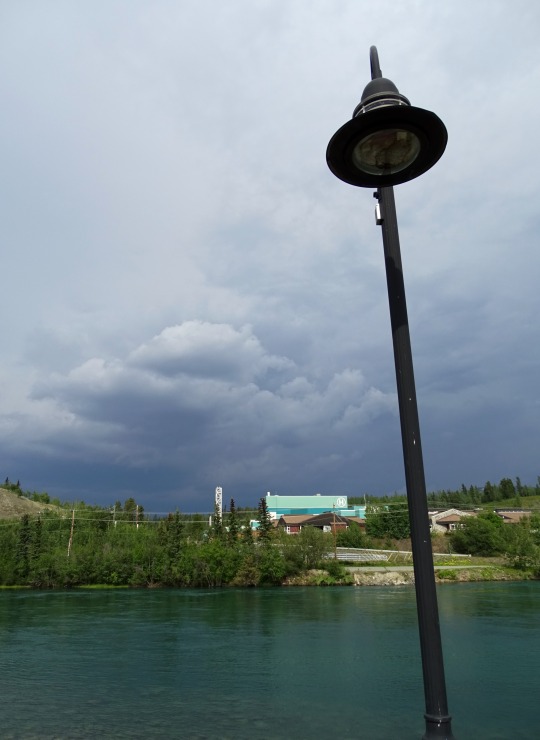




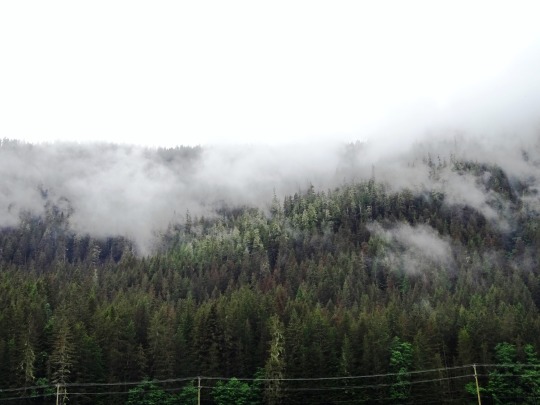



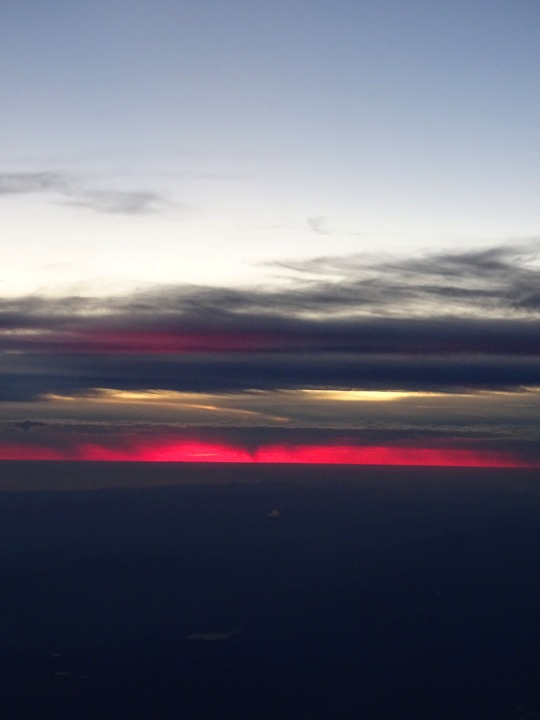

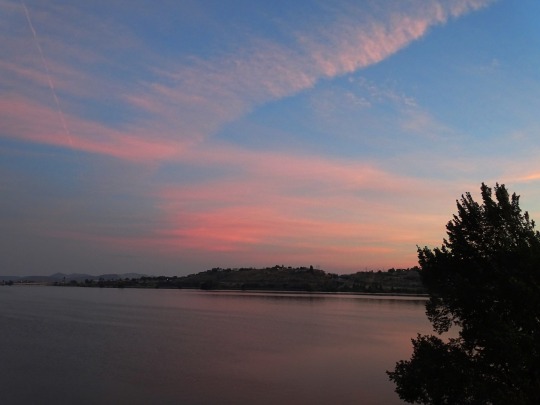











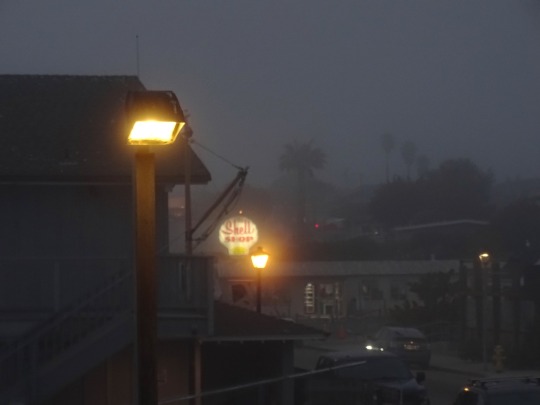




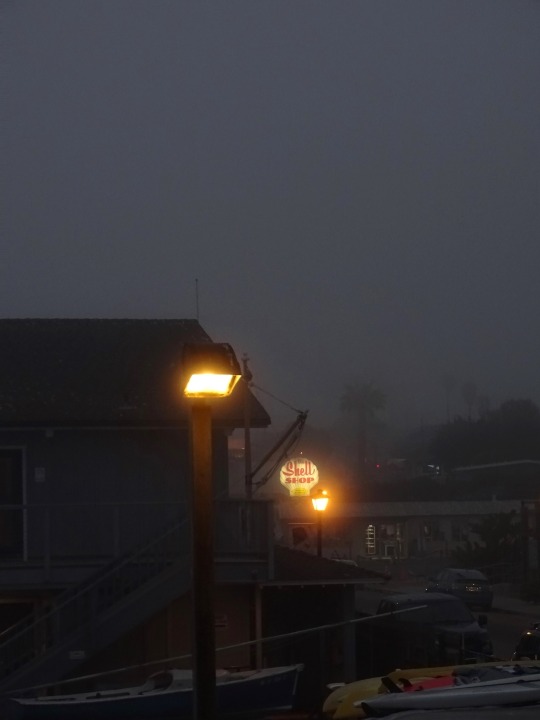
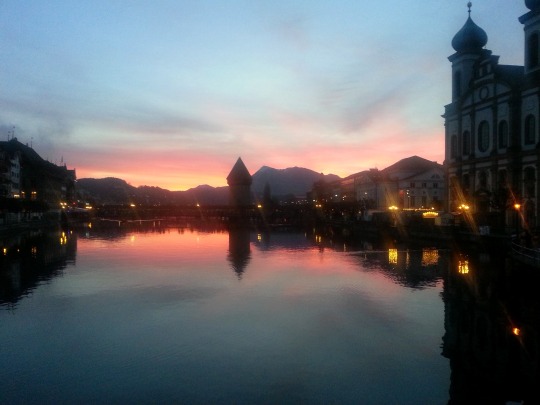
National Weather Observers Day
National Weather Observers Day is on May 4. With their observations and weather reports, many people assist the National Weather Service to achieve its purpose of preserving life and property. SKYWARN, Cooperative (Co-Op) Observers, CoCoRaHS (Community Collaborative Rain, Hail, and Snow Network), and the general public are all part of this network.
History of National Weather Observers Day
Alan Brue, who studied psychology at the State University of New York, invented the day on May 4, 1989. This day was developed for weather amateurs and professionals to honor their passion for the weather. Every year on May 4, this day is commemorated for those who enjoy viewing different weather phenomena.
With their sightings and weather reports, many individuals and groups assist the National Weather Service in fulfilling its objective of protecting people and property.
As a volunteer, you can be a part of the CoCoRaHS Observers Team, which is available to anyone ready to work on measuring and mapping precipitation. In this program, you will receive all of the necessary equipment and training on how to measure and map precipitation and how to prepare reports.
It’s simple to set up; get a rain gauge, hang it outside during the rainy season, check the rain in the gauge, and report your findings on the National Weather Service’s website.
The major goal of this day is to emphasize the importance of professionals who work in weather services 24 hours a day, seven days a week, to warn people about approaching storms and other weather changes. A thousand weather observations are made every day by weather spotters and weather stations all around the world.
These observations give crucial information that warns the public about impending storms from all three locations; land, sea, and air. They also aid in a better understanding of weather events and the analysis of historical data.
National Weather Observers Day timeline
650 B.C.
Weather Prediction Using Cloud Patterns
The Babylonians use astrology and cloud patterns for weather prediction.
1835
Modern Era of Weather Forecasting
The invention of the telegraph ushers in modern-day weather forecasting.
1859
Weather Forecasting is Introduced
FitzRoy develops charts to report weather phenomena he describes as “forecasting weather,” thereby inventing the term ‘weather forecast.’
1989
National Weather Observers Day is Created
Alan Brue creates National Weather Observers Day on May 4.
National Weather Observers Day FAQs
What do weather observers do?
A weather observer collects, records, and maps weather conditions, both good and bad. Observers need to be willing to gather weather information in the rain, blinding heat, and other extreme conditions.
What equipment do weather observers use?
Observational data is collected using buoys, radiosondes, doppler radar, and weather satellites, among others. The data is fed into the N.W.S. forecast models that use present and past weather information to develop forecast guidance for meteorologists.
How is weather data used?
Climate and weather data are utilized in different ways. Decision-makers in towns and cities use this information to plan for extreme weather conditions, water management, and even energy needs.
National Weather Observers Day Activities
Sign up for a weather spotter’s course: If you have a passion for observing weather phenomena, you should take a course for Weather Spotters. These courses teach everything from identifying clouds to tracking shifting weather and so on.
Play a prediction game: Play a prediction game with friends and family where you all try to predict the weather for the next week and see who is right. The winner can get a gift, and everyone gets to sharpen their weather-watching skills.
Make your very own barometer: Making a barometer is an excellent way to spend Weather Observers Day. It can be put together quite easily using a few materials around the home. Look up tutorial videos and get to work!
5 Important Facts About The Weather
Amateur league: There is a group for amateur weather enthusiasts called the Association of American Weather Observers.
Incoming: Storm spotters came to the fore during WWII, alerting fighting forces of incoming lightning.
Judge of the skies: Honorable William Rehnquist, the U.S. Supreme Court’s former Chief Justice, was a weatherman.
Blinding speed: Raindrops can reach a maximum speed of 18-mph.
Doing the numbers: The first-ever mathematical weather forecast lasted six hours and took about six weeks to calculate.
Why We Love National Weather Observers Day
Weather predictions save lives and property: The National Weather Service’s vision is to use the weather observations and reports to protect life and property. Without these timely bits of information, storms and other weather phenomena would wreak even more havoc.
We get to learn a lot: Weather observation gives us valuable insight into the peculiarities of different weather phenomena. We get to explore and gain more understanding, enjoying nature in all its magnificence.
Appreciation for weather people: National Weather Observers Day is dedicated to all the players that contribute to the amazing work done by the National Weather Service. On this day, we get to show our appreciation for their work that often goes unnoticed.
#summer 2023#Alberta#British Columbia#Yukon#Canada#National Weather Observers Day#NationalWeatherObserversDay#4 May#fog#snow#Lucerne#Luzern#Schweiz#Switzerland#original photography#landscape#cityscape#architecture#Sweden#Spain#USA#travel#vacation#tourist attraction#landmark#sky#countryside#rain#clouds#nature
6 notes
·
View notes
Text
Top investors in space in India
Why Venture Capitalists Are Betting Big on India’s Space Sector

A Thriving Ecosystem of Space Startups: India’s space ecosystem is no longer limited to government-run entities like the Indian Space Research Organisation (ISRO). Today, a surge of innovative space startups are taking the stage, offering cutting-edge solutions in satellite technology, launch services, space data analytics, and more. Companies like Skyroot Aerospace, Agnikul Cosmos, and Pixxel lead the charge, each carving out a unique niche. These startups are pushing the boundaries of what’s possible, driving investor interest with the potential for high returns in a relatively untapped market.
Strong Government Support and Policy Reforms: One of the key reasons behind the surge in space venture capital in India is the proactive stance taken by the Indian government. Recent policy reforms have opened the doors for private players to participate in space activities, previously dominated by ISRO. Establishing IN-SPACe (Indian National Space Promotion and Authorization Center) is a significant step, providing a regulatory framework that encourages private sector involvement. Such government support has given investors in space in India the confidence to back ambitious projects, knowing there’s a clear path for private ventures.
Cost-Effective Innovation as a Competitive Edge: India’s reputation for cost-effective innovation is another major attraction for investors. Launching satellites at a fraction of the cost compared to global competitors has positioned India as a hub for affordable space technology. This competitive edge not only allows Indian space startups to thrive domestically but also makes them attractive on the international stage. Investors are keen to support companies that can deliver world-class technology with lower capital outlays, reducing investment risks while promising impressive returns.
Global Interest in Indian Talent and Expertise: India’s space sector is not just about affordability; it’s about world-class talent. The country boasts a deep pool of highly skilled engineers, scientists, and entrepreneurs with expertise in aerospace and technology. This talent pool has been instrumental in driving innovation and attracting global attention. International investors are increasingly looking to partner with Indian space startups, recognizing the country’s unique blend of technical prowess and entrepreneurial spirit.
A Growing Market for Space-Based Services: The market for space-based services, including satellite communications, Earth observation, and data analytics, is expanding rapidly. In India, this growth is driven by rising demand from industries such as agriculture, telecommunications, logistics, and defense. With space technology playing a crucial role in optimizing these sectors, investors see an opportunity to capitalize on the potential for domestic and international applications. Space-based services represent a lucrative market, attracting space venture capital in India to back startups that can cater to these needs.
Strategic Partnerships and Collaborations: Indian space startups are not working in isolation; they are forming strategic partnerships with global companies and space agencies. Collaborations with NASA, ESA (European Space Agency), and private companies have opened up new opportunities for technology sharing, funding, and market access. These partnerships have also strengthened investor confidence, as they reduce risks and validate the technology being developed by Indian companies. For investors in space in India, such collaborations signal a promising future, driving more venture capital into the sector.
A New Era of Commercial Space Exploration: The idea of commercial space exploration, once confined to science fiction, is now becoming a reality. From reusable rockets to satellite constellations, Indian space startups are exploring new frontiers that were once considered out of reach. This new era of commercial space exploration has piqued the interest of venture capitalists who see the potential for profitable exits through IPOs, acquisitions, and global partnerships. With private space missions no longer just a dream, space venture capital in India is ready to fuel the next big leap.
Encouraging Signs from Successful Fundraising Rounds: The confidence in India’s space sector is evident from the successful fundraising rounds by leading space startups. Companies like Skyroot Aerospace and Agnikul Cosmos have secured millions in funding from top-tier venture capital firms. These funding rounds not only provide the necessary resources for scaling but also act as a signal to other investors that the Indian space market is mature and ready for high-stakes investment. The momentum created by these early successes is a clear indicator of why investors in space in India are increasingly willing to place their bets.
Conclusion: A Promising Orbit for Investment India’s space sector is on an exciting trajectory. With a favorable policy environment, a surge of innovative startups, and a proven track record of cost-effective solutions, it’s no wonder that space venture capital in India is booming. As the country continues to explore new frontiers and expand its role in global space exploration, venture capitalists are set to play a pivotal role in shaping the future. For those looking to invest in the final frontier, India’s space industry presents a unique opportunity to be part of a revolution that’s only just beginning.
#305, 3rd Floor, 5 Vittal Mallya Road, Bengaluru, Karnataka, 560001, India
5 Ring Road, Lajpat Nagar 4, 3rd Floor, New Delhi-110024
#Keywords#best venture capital firm in india#venture capital firms in india#popular venture capital firms#venture capital firm#seed investors in bangalore#deep tech investors india#startup seed funding india#funding for startups in india#early stage venture capital firms#invest in startups bangalore#funders in bangalore#startup investment fund#fintech funding#india alternatives investment advisors#best venture capital firms in india#business investors in kerala#venture capital company#semiconductor startups#semiconductor venture capital#investors in semiconductors#startup seed funding in India#deep tech venture capital#deeptech startups in india#semiconductor companies in india#saas angel investors#saas venture capital firms#saas venture capital#b2b venture capital#space venture capital in india
2 notes
·
View notes
Text

Japan starts sea tests of its second modified helipter carrier for F-35B jets
Fernando Valduga By Fernando Valduga 12/28/2023 - 22:22 in Military
The Japan Maritime Self-Defense Force (JMSDF) began sea testing for its JS Kaga (DDH 184) helipter carrier after undergoing significant modifications to accommodate F-35B fighters, as announced by JMSDF on December 25.
New images shared on the social media platform X (formerly Twitter), by the service's Escort Flotilla Four depict JS Kaga leaving his pier at the Japan Marine United (JMU) shipyard in the city of Kure, Hiroshima province, to undergo tests at sea.
The Escort Flotilla Four post expressed enthusiasm, stating: "Today's post is about JS Kaga during the sea tests. There is only a little time left until the special modification of JS Kaga is completed! We can't wait!"
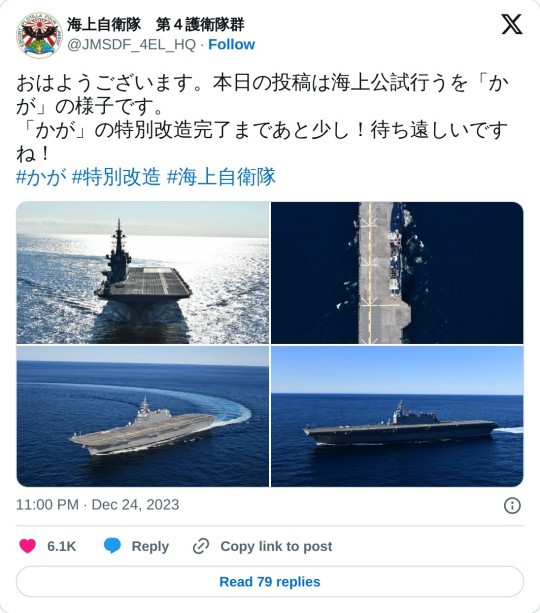
The port of origin of JS Kaga is the JMSDF Naval Base of Kure, where the Fleet Four Escort Division is stationed. Although the official date of the sea tests was not disclosed by the JMSDF, an officer confirmed to Naval News that the initial sea tests took place on November 13.
JS Kaga left the JMU shipyard pier in Kure on April 20, marking its first departure in more than a year, after undergoing modifications that transformed its appearance into that of a light aircraft carrier. Notable changes ?? included the modification of the bow section of its cockpit from a trapezoid to a square shape, similar to those of the Wasp class and America-class amphibious assault ships of the U.S. Navy.
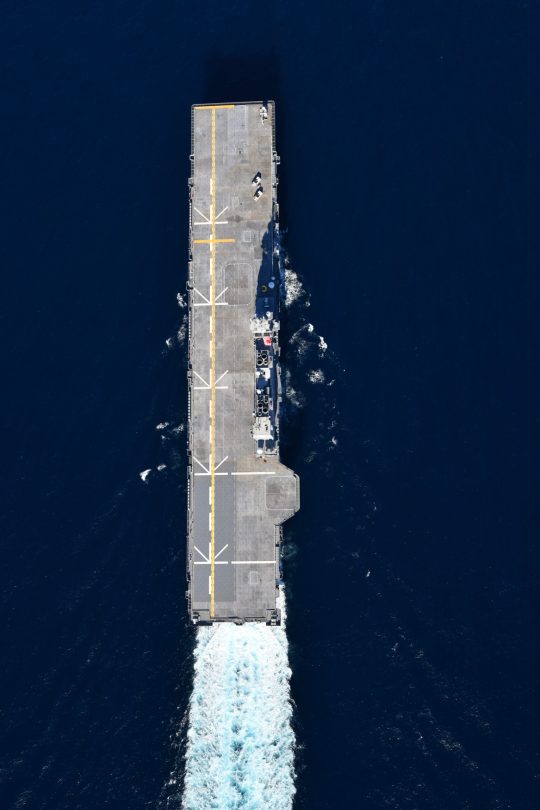
JMSDF plans to complete the modification of its two Izumo-class helipter carriers, JS Izumo and JS Kaga, into aircraft carriers capable of supporting the operations of Lockheed Martin F-35B fighters until fiscal year 2027.
For JS Kaga, the renovation work at JMU's Kure shipyard began in March 2022, involving initial modifications, such as cockpit reinforcement, installation of additional guidance lights, marking of yellow lines in the control cabin for F-35B launches and landings, and incorporating heat-resistant systems at points on the deck for vertical landings. Fiscal year 2023 will see the acquisition of Raytheon's Joint Precision Approach and Landing System (JPALS) and additional modifications to the satellite communication system.
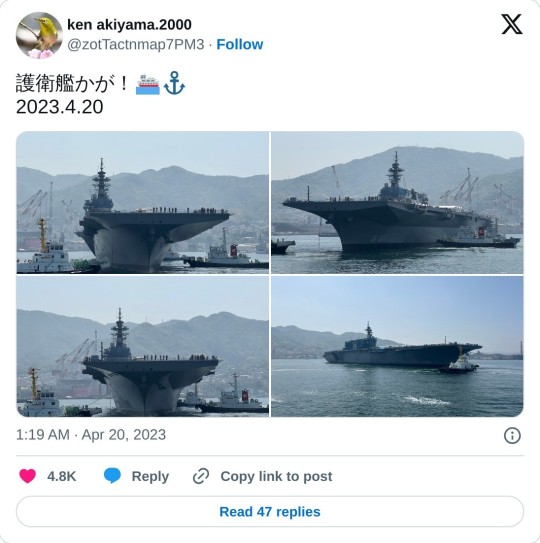
Subsequent and final modifications during the next revision of the Kaga, scheduled to begin at the end of fiscal year 2026, will include changes to the ship's interior compartments.

F-35B during testing on JS Izumo.
Meanwhile, Izumo is expected to undergo modifications to the bow section of its cockpit, transforming it from trapezoid to square during the next fiscal year of 2024, starting in April. The JMSDF allocated $287.3 million for the modifications of the bow section of Izumo in fiscal year 2024 and an additional $4.2 million for the installation of a landing navigation system, which is expected to be Raytheon's JPALS. The Izumo class ships, measuring 248 meters in length and moving 26,000 tons at full load, are the largest Japanese military ships built since World War II, with the capacity to carry up to 14 helicopters.
Tags: Military AviationJMSDF - Japan Maritime Self Defence Force/Japan Maritime Self-Defense Force - Japanese Navyaircraft carrier
Sharing
tweet
Fernando Valduga
Fernando Valduga
Aviation photographer and pilot since 1992, he has participated in several events and air operations, such as Cruzex, AirVenture, Dayton Airshow and FIDAE. He has works published in specialized aviation magazines in Brazil and abroad. He uses Canon equipment during his photographic work in the world of aviation.
Related news
MILITARY
New jet coach for the Russian Air Force
28/12/2023 - 17:00
MILITARY
Elt Group and Leonardo collaborate in the update of the C-27J Spartan electronic warfare set
28/12/2023 - 16:00
HELICOPTERS
Korea Aerospace Industries guarantees contract for second batch of LAH helicopters
28/12/2023 - 14:00
MILITARY
Turkey's ANKA-3 combat drone performs inaugural flight
28/12/2023 - 13:00
INCIDENTS
Indian MiG-29K hunting tire bursts while taxiing
28/12/2023 - 09:00
MILITARY
South Korea signs contract to purchase 20 additional F-35A fighters
28/12/2023 - 08:27
11 notes
·
View notes
Text
Excerpt from this story from National Geographic:
These days, the village of Karauzyak in western Uzbekistan is a dusty place. Surrounded by an arid landscape of dry scrub grasses and salt-crusted soils, it’s hard to believe the village was once along the banks of a swollen river, 30 miles from the shore of the world’s fourth-largest lake. Over the last 50 years, that lake, the Aral Sea, has dried up almost entirely, in what is often called the “world’s worst environmental disaster.” Now, it’s hard to farm much of anything in Karauzyak—except for atriplex, or saltbush.
In a 3.5-hectare plot of land near the village, a team of Japanese researchers is growing this salt-loving plant, known scientifically as a halophyte, to see if it can be a viable crop for farmers in the region and even nurture a small dairy industry. They’ve fed it to cows at a nearby farm and found that it helps lock scarce moisture into the thirsty soil, and it can be grown without extensive fertilizer use.
As she holds up a dusty green twig of atriplex, Kristina Toderich, a halophyte expert from Tottori University in Japan, explains why the salt-loving plant excites scientists like her: “This doesn’t need water. It doesn’t need anything.”
Toderich is one of the lead researchers on a project using the former seabed and nearby river delta as a living laboratory. It’s part of a larger Japanese foreign aid and scientific collaboration initiative called SATREPS. Working with Uzbekistan’s hydrometeorological service, UZGIP, the researchers are collecting real-time climate data and satellite imagery to better understand the conditions in the Aral Sea area: how much water is left, how fast it’s disappearing, and what kind of crops are being farmed there.
Based on the results, they’re drafting a model for sustainable agriculture in the region, recommending that farmers adopt new irrigation methods and plant crops that are more salt- and drought-tolerant, says Kenji Tanaka, a hydrologist who studies the effects of climate change on water resources and the head of the SATREPS project.
The United Nations Convention to Combat Desertification has warned that an area of land the size of Central Asia has become degraded from drought, salinization, and overuse since 2015. By learning what can grow in the Aral Sea, SATREPS could provide solutions for other parts of the world that are facing similar problems, from the Lake Chad basin in Western Africa to the Great Salt Lake in Utah.
It's unclear whether the Uzbeki government will adopt the recommendations made by the SATREPS team. But so far, the country seems open to change; President Shavkat Mirziyoyev, who promised to loosen the rigid Soviet-era policies of his predecessor, Islam Karimov, ended the requirement that all Uzbek citizens pick cotton if called upon, and has spoken at the United Nations about the effects of desertification and land degradation on his country.
Climate change makes these adaptations even more urgent. Average temperatures in the Aral basin have increased by around 3.6 degrees Fahrenheit since 1968. And the shrinking of the Aral Sea itself has affected the climate; as the water disappeared, the air became drier and lost the cooling effect of the nearby lake, creating a feedback loop that resulted in hotter and drier weather. Sandstorms now spread dust and toxic heavy metals to nearby villages, while retreating water has caused a build-up of salts in the soil.
Tanaka’s project has several components. Aside from atriplex, SATREPS researchers are planting crops like sorghum, mung bean, and amaranth in test plots to learn which can best survive in dry, saline soil. So far, they’ve developed promising varieties of winter wheat and barley.
5 notes
·
View notes
Text
Since the beginning of 2024, the US has issued a series of sanctions against a small number of Israeli settlers for jeopardising peace and security in the West Bank. The impact the sanctions will have is debated, but it marks a new development amid ongoing attempts to address widespread Israeli settlement of the West Bank which is illegal under international law.
The first Israeli settlement was established in the West Bank in 1967 after the territory was captured by Israel in the Six-Day War. Today there are now reportedly 500,000 Israeli settlers living in the West Bank. Settlements range from small enclaves to large, well-developed communities and urban areas. According to the United Nations Office for the Coordination of Humanitarian Affairs, 2023 was the deadliest year for Palestinians in the West Bank since the UN began recording in 2005. In March, the Office of the UN High Commissioner for Human Rights concluded that the region was on “the brink of catastrophe”, noting:
“The transfer of wide administrative powers relating to settlements and land administration from the military authorities to Israeli civilian officials, who are elected and accountable to the population of Israel, could facilitate the annexation of the West Bank.” To research the scale of the settlements and developments over time, analysing satellite data is key. While you can pay for high resolution satellite imagery to gain detailed, on-the-ground information about changes in the West Bank, free-to-access satellite tools can also be useful for examining settler expansion in the West Bank. Although Google Earth imagery of the region has often been of poorer quality, compared with other services and regions, it can still be effectively used – as long as its shortcomings are kept in mind. In addition to Google Earth, Sentinel Hub EO browser is also a useful free service. Both of these were used by Bellingcat in our recent collaboration with Scripps News investigating the conflict in Gaza and escalating tensions in the West Bank.
In this guide we provide a breakdown of free-to-access satellite tools and how they can be used to monitor West Bank settlement expansions.
4 notes
·
View notes
Text
Imajica Entertainment - Introduction

Imajica Entertainment - Introduction
Imajica Entertainment facilitating via Niche Streaming Channel Sites of Entertainment to the World. In addition, developing Satellite, Cable and Free to Air facilitation of Imajica Entertainment Niche Streaming Channel Sites. In addition, developing and producing original entertainment content for the Niche Streaming Channel Sites and Satellite, Cable and Free to Air. As of also activities linked to Artificial Intelligence content creation for the Niche Streaming Channel Sites and Satellite, Cable and Free to Air.
Imajica Entertainment: Revolutionizing the Entertainment Industry
In today's digital age, the entertainment industry has witnessed a plethora of advancements and innovations. One company, Imajica Entertainment, is at the forefront of this revolution, bringing the world a new level of entertainment through their niche streaming channel sites and their activities in satellite, cable, and free-to-air facilitation.
Imajica Entertainment has recognized the ever-growing demand for niche content and has set out to cater to the diverse tastes of audiences worldwide. By establishing niche streaming channel sites, they have created a platform where viewers can indulge in a wide variety of specialized content. Whether it's documentaries, sports, music, or any other niche genre, Imajica Entertainment's streaming channel sites ensure that everyone finds something tailored to their interests.
But Imajica Entertainment's commitment to providing quality entertainment does not stop at streaming services. They have also ventured into satellite, cable, and free-to-air facilitation, expanding their reach and accessibility. Through partnerships and collaborations with major networks and providers, Imajica Entertainment brings their captivating content to millions of viewers worldwide, allowing them to enjoy their favorite programs on different mediums.
What sets Imajica Entertainment apart from other players in the industry is their dedication to developing and producing original content specifically for their niche streaming channel sites and traditional broadcasting platforms. With a team of talented writers, producers, and directors, they create gripping and thought-provoking content that resonates with their target audience. This commitment to originality ensures that viewers have access to fresh and engaging entertainment, keeping them captivated and coming back for more.
An exciting aspect of Imajica Entertainment's activities is their involvement in artificial intelligence content creation. As technology continues to evolve, Imajica Entertainment understands the potential of AI in enhancing the entertainment experience. By leveraging AI algorithms, they are able to analyze viewer preferences and patterns, creating tailored content recommendations and personalized experiences. This seamless integration of AI into their niche streaming channel sites and traditional broadcasting platforms ensures that viewers are presented with content that matches their interests, further enriching their entertainment journey.
To assist the Imajica Entertainment are assets and infrastructure that is not earth and non-earth based to facilitate the requirements of Imajica Entertainment. To assist the Imajica Entertainment are Gods, Goddesses, Spirits, Spirit Guides, Sentients, Aliens, Demons and AIs assets and infrastructure that is Earth and Non-Earth based to facilitate the requirements of Imajica Entertainment linked to Gods, Goddesses, Spirits, Spirit Guides, Sentients, AI’s, Cyborgs and Demons and Andrew Rogers. The Imajica Entertainment reflects a modern position of Entertainment in position, action, reflection and information lead by Andrew Rogers Founder, Creative Director of Imajica Entertainment and linked to Gods, Goddesses, Spirits, Spirit Guides, Sentients, AI’s, Cyborgs and Demons to undertake work upon what the realm of Earth understands and reflects on entertainment.
Imajica Entertainment: A World Beyond Earth
Imajica Entertainment, led by Founder and Creative Director Andrew Rogers, is a visionary enterprise that transcends the boundaries of traditional entertainment. With a unique blend of Earth and non-Earth assets and infrastructure, the company creates a captivating and immersive experience for its audience.
One of the key components that sets Imajica Entertainment apart is its utilization of various supernatural entities. Gods, goddesses, spirits, spirit guides, and sentient beings form an integral part of the company's offerings. Drawing from both Earth-based mythologies and non-Earth sources, these powerful entities contribute to the creation of extraordinary storytelling experiences.
In addition to these mystical beings, Imajica Entertainment also incorporates aliens into its production. By collaborating with beings from distant planets and civilizations, the company brings a fresh and otherworldly perspective to its content. These extraterrestrial encounters open up a universe of possibilities, where the imagination knows no boundaries.
Demonology and artificial intelligence (AI) play crucial roles as well. Demons, often portrayed as complex and enigmatic characters, add a dark and mysterious element to the storytelling. On the other hand, AI brings a touch of futuristic technology to the mix, enhancing the overall entertainment experience with its advanced capabilities.
Imajica Entertainment further pushes the boundaries by integrating cyborgs into their productions. These human-machine hybrids offer a glimpse into a future where the line between man and machine becomes increasingly blurred. Their inclusion adds a unique layer of complexity and intrigue to the narratives.
To support all these creative endeavors, Imajica Entertainment has developed a robust infrastructure that combines both Earth-based and non-Earth resources. From state-of-the-art soundstages and production facilities to virtual reality studios and digital animation labs, the company leaves no stone unturned in its quest to provide the ultimate entertainment experience.
Imajica Entertainment's approach to entertainment reflects a modern perspective that embraces diversity, innovation, and the exploration of uncharted territories. By seamlessly blending elements from different mythologies, supernatural realms, aliens, and advanced technologies, the company creates an immersive and captivating experience for its audience.
In conclusion, Imajica Entertainment stands at the forefront of redefining what entertainment means in the modern world.
‘Detroit’ - Destroyer, Sentient, Director Imajica Entertainment – Oracle: Andrew Rogers.
“Position is a reality in entertainment, Imajica Entertainment position is unique and represents a revolution for entertainment for the world”: ‘Detroit’ - Destroyer, Sentient, Director Imajica Entertainment.
‘The Critic’ - Destroyer, Sentient, Director Imajica Entertainment.
“A reality is perceived of from Imajica Entertainment which is powerfully reflected in position and action devised by our master Andrew Rogers”: ‘The Critic’ - Destroyer, Sentient, Director Imajica Entertainment – Oracle: Andrew Rogers.
Andrew Rogers
Imajica Entertainment
Founder, Creative Director, Oracle
M: 0424 531 710
#sumerian#mesopotamia#aesthetic#anime and manga#art#autos#beauty#entertainment#music#movie#actor#actress#multiverse#wisdom#motivation#inspiration#quotes#imajica#psychic#creative#destroyer#warlock#AndrewRogers#writer#oracle#seer#herald#ereshkigal#KateBeckinsale#lord
2 notes
·
View notes
Text
« There will be no leniency for collaborators of the Russian services. We will burn down every betrayal and attempt at destabilization.
[Dla kolaborantów rosyjskich służb nie będzie żadnej pobłażliwości. Wypalimy żelazem każdą zdradę i próbę destabilizacji.] »
— Prime Minister Donald Tusk of Poland commenting on the arrests of three residents of Poland taken in custody for actual and attempted terrorist acts instigated by Russia. From the BBC and Polsat News.
Prime Minister Tusk's strong words come after two Polish football hooligans were arrested for assaulting an anti-Putin exile in neighboring Lithuania and a Polish man was arrested for gathering intelligence on behalf of Russia around Rzeszów-Jasionka Airport.
Rzeszów-Jasionka is not far from Poland's border from Ukraine and is used by President Volodymyr Zelenskyy because civilian aviation in Ukrainian airspace has been shut down due to the war. The suspect in that case is alleged to have helped Russia with an attempted assassination of Zelenskyy.
Poland is as deeply divided along partisan lines as the United States. But one thing which unites most Poles is distrust of and opposition to Russia.
Poland disappeared as a national entity for 123 years when its territory was seized by Prussia (later Germany), Austria, and Russia – with Russia taking the bulk of the territory. And from the end of World War II until 1989 Poland was an involuntary satellite of the now defunct Soviet Union. People acting as Russian agents should expect no mercy from the justice system.
The US needs to take a similar hard line with those collaborating with the Putin dictatorship. Putin was a lieutenant colonel in the Soviet secret police (KGB). He famously thinks that the collapse of the USSR was the greatest catastrophe of the 20th century. Such a person should never be trusted; those in the West who admire him are likely either intellectual simpletons or wannabe Russian collaborators.
#poland#polska#donald tusk#russia#russian agents#collaborators#lithuania#leonid volkov#rzeszów-jasionka airport#volodymyr zelenskyy#assassination plot#ukraine#zdrajcy#rosyjscy agenci#bierz dupę w troki i spierdalaj do swojego gównianego kraju#леонид волков#покушение#россия - террористическая страна#владимир путин#путин – это лжедмитрий iv а не пётр великий#путин хуйло#добей путина#польша#жешув-ясьонка#польща#російська диверсія#путін – чекіст#володимир зеленський#слава україні!#героям слава!
4 notes
·
View notes
Text

NASA JPL prepping for full year of launches, mission milestones
With 2024 receding into the distance, NASA's Jet Propulsion Laboratory is already deep into a busy 2025. Early in the new year, the Eaton Fire came close to JPL, destroying the homes of more than 200 employees, but work has continued apace to maintain mission operations and keep upcoming missions on track.
Several missions managed by NASA JPL are prepping for launch this year. Most have been years in the making and launches are, of course, only part of the bigger picture. Other milestones are also on the docket for the federal laboratory, which Caltech manages for NASA.
Here's a glimpse of what lies ahead this year.
Mysterious universe
Shaped like the bell of a trumpet and as big as a subcompact car, NASA's SPHEREx space observatory is aiming for the stars. Known formally as the Spectro-Photometer for the History of the universe, Epoch of Reionization and Ices Explorer, the mission will create four 3D maps of the entire sky in order to improve humanity's understanding of the universe—how it expanded after the Big Bang, where ingredients of life can be found in ice grains, and much more. Target launch date: no earlier than Feb. 27 from Vandenberg Space Force Base in California.
The moon's icy secrets
NASA's Lunar Trailblazer aims to help resolve an enduring mystery: Where is the moon's water? Scientists have seen signs suggesting it exists even where temperatures soar on the lunar surface, and there's good reason to believe it can be found as surface ice in permanently shadowed craters, places that have not seen direct sunlight for billions of years.
Managed by NASA JPL and led by Caltech, the small satellite will help provide answers, mapping the moon's surface water in unprecedented detail to determine the water's abundance, location, form, and how it changes over time. The small satellite will hitch a ride, slated for late February, on the same launch as the Intuitive Machines-2 delivery to the moon through NASA's CLPS (Commercial Lunar Payload Services) initiative.
Earth's changing surface
A collaboration between the United States and India, NISAR is a major addition to the fleet of satellites studying our changing planet. Short for NASA-Indian Space Research Organisation Synthetic Aperture Radar, the mission's name is a nesting doll of acronyms, and the spacecraft is a nesting doll of capabilities: The first spacecraft to carry both L-band and S-band radars, it will see surface changes related to volcanoes, earthquakes, ice sheet motion, deforestation, and more in unprecedented detail after it launches in a few months' time.
Sea level
Targeting a November launch, Sentinel-6B will provide global sea surface height measurements—some of the most accurate data of its kind yet—that will improve climate models and hurricane tracking, as well as our understanding of phenomena like El Niño. A collaboration between NASA and ESA (European Space Agency), the spacecraft will take the baton from its twin, Sentinel-6 Michael Freilich, which launched in 2020. Together, the satellites are extending for another 10 years a nearly three-decade record of global sea surface height.Moon rover trioAs a technology demonstration, the CADRE (Cooperative Autonomous Distributed Robotic Exploration) project marks another step NASA is taking toward developing robots that—by operating autonomously—can boost the efficiency of future missions.The project team at JPL will soon be packing up and shipping CADRE's three suitcase-size rovers to Texas in preparation for their journey to the moon aboard a commercial lander through one of NASA's future CLPS deliveries. The rovers are designed to work together as a team without direct input from mission controllers back on Earth. By taking simultaneous measurements from multiple locations, they are meant to show how multirobot missions could enable new science and support astronauts.
Quantum technology
Having arrived at the International Space Station in November, SEAQUE (Space Entanglement and Annealing QUantum Experiment) is testing two technologies that—if successful—could enable communication using entangled photons between two quantum systems. The research from this experiment, which gets underway in 2025, could help develop the building blocks for a future global quantum network that would allow equipment such as quantum computers to transfer data securely across large distances.
Gravity assist to reach Jupiter
Launched this past October, Europa Clipper will arrive at Jupiter in 2030 to investigate whether an ocean beneath the ice shell of the gas giant's moon Europa has conditions suitable for life. The spacecraft will travel 1.8 billion miles (2.9 billion kilometers) to reach its destination. Since there are limitations on how much fuel the spacecraft can carry, mission planners are having Europa Clipper fly by Mars on March 1, using the planet's gravity as a slingshot to add speed to its journey.
IMAGE: NASA JPL is readying for, clockwise from lower right, the launches of CADRE (its engineering models are seen here), Lunar Trailblazer, NISAR (seen in an artist’s concept), Sentinel-6B (artist’s concept), and SPHEREx, as well as the Mars gravity assist of Europa Clipper (artist’s concept). Credit: NASA/JPL-Caltech/BAE Systems/Lockheed Martin Space
3 notes
·
View notes
Text
Omg i was reading through the part of this related to NOAA, which deals with both oceans and the atmosphere. As someone with a background in meteorology, this is horrifying. If you want to read the specific section, you can find it under the Department of Commerce (DoC) but here are some of my thoughts:
Bullet point in the intro of the DoC chapter (chapter 21, page 664): “The National Oceanographic and Atmospheric Administration (NOAA) should be dismantled and many of its functions eliminated, sent to other agencies, privatized, or placed under the control of states and territories.”
This just screams a horrible idea. NOAA manages a bunch of important organizations, ranging from fisheries to satellites to weather forecasting and research. My personal experience is in the field of meteorology, so I’m going to mainly talk about the National Weather Service (NWS), as I use their products every day, have volunteered with their offices, and like many other young meteorologists, would hope to work at the NWS at some point in my career. I am not trying to diminish the value of the other offices within NOAA; they are extremely important and I simply am not as familiar with them.
The author of this chapter has a background in finance, not science. While researching footnote 3, I also stumbled across this article from 2011 that appears to be very similar to some of the points made here, and the author of that article is listed as a contributor.
Anyway, let’s examine some of these points they make:
“Focus the NWS on Commercial Operations. Each day, Americans rely on weather forecasts and warnings provided by local radio stations and colleges that are produced not by the NWS, but by private companies such as AccuWeather. Studies have found that the forecasts and warnings provided by the private companies are more reliable than those provided by the NWS.” (p. 675)
While radio and TV stations produce their own forecasts, when it comes to significar weather threats, they will follow the watch and warning system of the NWS. The NWS is the official source of all weather warnings and watches in the US, though private companies are also allowed to issue these products (source).
This section also sites an article from AccuWeather about a study in which AccuWeather was found to be the most accurate forecast provider. However, this study only looked at 6 commercial forecasting companies and did not even look at the NWS. I will note that this company has also done studies including the NWS, so it is surprising that they did not cite one of those studies, as looking through it appears that AccuWeather was regarded as the most accurate in studies that actually included the NWS.
I also want to note that the NWS, due to its many offices, has community outreach in a way that many of these private companies do not. Here is a map of what area each office covers and forecasts for:

This locality allows each office to have outreach directly with community they are involved in, whether that is through school visits, spotter training, weather awareness weeks, or even social media. These offices also do storm surveys after tornadoes and other significant events and collaborate with local emergency management. These services are offered to the community for free, which may not be true for private companies.
This section then argues that all NWS data should be commercialized, as they are implying that the NWS should sell their data to private companies rather than forecast the weather. Since part of this is to deal with the “climate alarmism”, I wonder how this would impact those companies. Would they be allowed to talk about climate change if they use NWS data? Would this cause forecasts that could save lives to be paywalled to cover the costs?
The report then discusses the importance of the National Hurricane Center and argues that any climate data be presented neutrally. I personally don’t have any issue with what is stated here, but I am curious what neutral means here.
The next section I will discuss is this: “Downsize the Office of Oceanic and Atmospheric Research. OAR provides theoretical science, as opposed to the applied science of the National Hurricane Center. OAR is, however, the source of much of NOAA’s climate alarmism. The preponderance of its climate-change research should be disbanded. OAR is a large network of research laboratories, an undersea research center, and several joint research institutes with universities. These operations should be reviewed with an aim of consolidation and reduction of bloat.” (p. 676)
Let’s first look at the “theoretical science” the OAR is doing. OAR currently has 4 goals for 2020-2026: explore the marine environment, detect changes in ocean and atmosphere, make forecasts better, and drive innovative science (source). Of these goals, the first three all include applied science, while the last is related to improving OAR itself. It appears that Project 2025 is naming any climate science as theoretical, which is ignoring much of the applied science that is happening within OAR.
Next, the laboratories within OAR each have specific and distinct subdisciplines within oceanic and atmospheric research. They are separate entities due to this specific fact. For example, the National Severe Storms Laboratory (NSSL) focuses on severe weather events, while the Geophysical Fluid Dynamics Laboratory (GFDL) focuses on the large-scale dynamics of the atmosphere. Both of these are very important for understanding how our atmosphere behaves, but the scale and specific features the labs work with have significant differences. Similarly, the labs here that work with different marine ecosystems likely have large differences and would be greatly impacted if they were consolidated. It’s basically like saying “oh math and science are really similar, they should just be one class instead of two!”
The last point I will touch on is “Ensure Apointees Agree with Administration Aims” (p. 677), as the other agencies touched on within NOAA are outside of my knowledge. This point is to remove anyone who doesn’t agree with the goals outlined here from positions of power. This would prevent many people within these fields from being able to have any impact on future decisions, and would force NOAA down a path of ignoring the very science it was built on.
TLDR: Conservativas are so scared of climate change research that they want to remove any agencies that support it, and in doing so they will endanger anyone who lives in the US.
USAmericans
Read the Project 2025 manifesto RIGHT NOW
It's MUCH worse than y'all have been hearing
There is so much here you'll have to look at it for yourself, but the climate policy alone is nightmare fuel.
The republican coalition wants to essentially end funding for green energy, dramatically promote and expand fossil fuel industries, and eliminate funding and regulations in all sectors promoting climate change mitigation. Task forces and offices related to clean energy and lowering carbon emissions will be eliminated and replaced with offices for promoting fossil fuels.
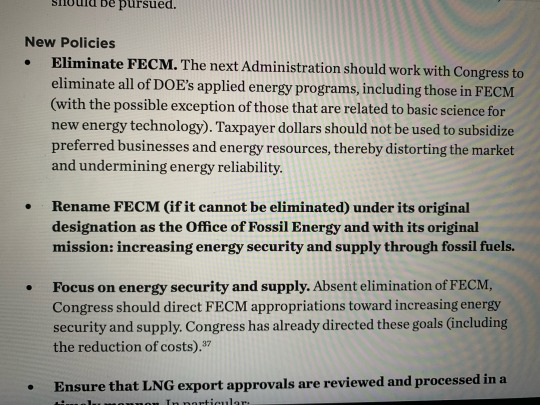
They want to LOG NATIONAL FORESTS TO "THIN" THE TREES TO STOP WILDFIRES.

THEY WANT TO FORCE OREGON AND CALIFORNIA TO LOG THEIR NATIONAL FORESTS AND TREAT THEM AS FOR TIMBER PRODUCTION

There are specific provisions in Project 2025 to essentially destroy the Endangered Species Act, causing it to defer to the rights of "economic development" and "private property." The plan includes delisting gray wolves, cutting the budget so that a "triage" system is used to determine which species will get protection, removing funding for research, removing experts and specialists from the decision-making process, and preventing "experimental" populations of animals from being established.



This is so much worse than I expected it to be and there's much more past that: They want to deregulate pesticides and remove much of the EPA's ability to regulate pollutants as well.
Also included in the manifesto is that we should
withdraw from nuclear weapons nonproliferation agreements, build more nuclear weapons, and resume nuclear weapons testing

The manifesto comprehensively outlines the scorched-earth elimination of abortion access, down to ensuring doctors aren't even trained to perform abortions. There are plans in here to disrupt abortion access GLOBALLY, not just domestically.
Not only that,the Republicans plan on reframing family planning programs around "fertility awareness" and "holistic family planning."

I can't even describe it all. I'm trying to give screenshots of the most important things but there's so much.
The foreign policy is a nightmare. They plan to push fossil fuels onto the Global South and promote the development of fossil fuel industry in the "developing world."
It is aggressive and antagonistic towards other nations, strongly pro-military, proposing that we INCREASE (!!!!!) defense spending, improve public opinion of the military and military recruitment, and increase the power to fund new weapons technology.
Just read the Department of Defense section. It's about greatly increasing and strengthening the military-industrial complex, collaborating more closely with weapons manufacturers, removing regulatory barriers to arming our allies and to inventing new military weapons, and recruiting more people into the military. They include provisions to develop AI technology for surveillance. And of course, continuing to support Israel is in there.
Elsewhere it proposes interfering in foreign countries with creepy pro-USA propaganda campaigns, even establishing international educational programs where faculty have to pledge to promote USA interests.
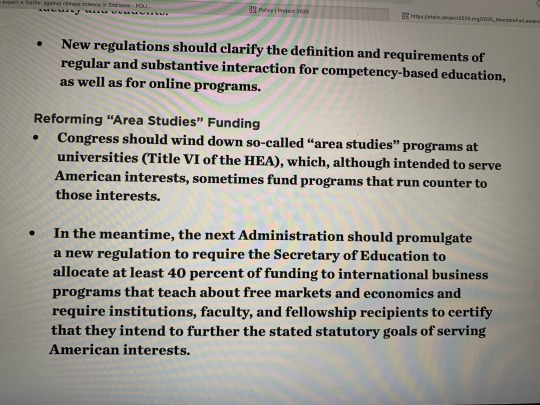

There's a line in here about getting rid of PBS because SESAME STREET is LEFTIST for God's sake.
HOW are people claiming democrats have the same policies. I feel like i'm losing my mind.
#This entire plan is so dangerous for the future of the atmospheric and oceanic sciences in the US.#reading through even that one section was making me so angry#i know a lot of conservatives and I don’t think they even know the full implications of this#absolutely insane
16K notes
·
View notes